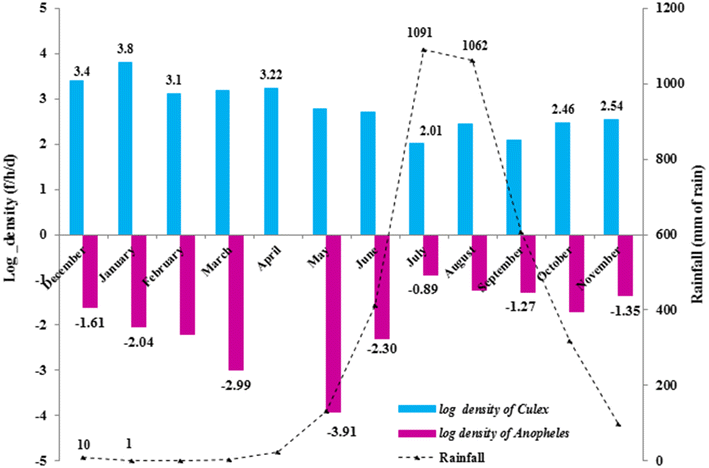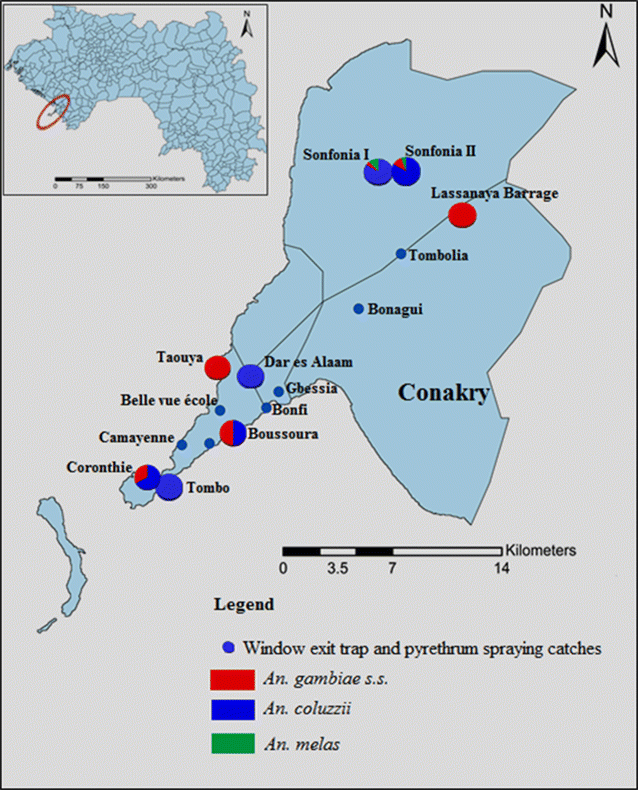Low prevalence of Plasmodium and absence of malaria transmission in Conakry, Guinea: prospects for elimination
- PMID: 26987480
- PMCID: PMC4797167
- DOI: 10.1186/s12936-016-1230-9
Low prevalence of Plasmodium and absence of malaria transmission in Conakry, Guinea: prospects for elimination
Abstract
Background: Over the past 15 years, mortality and morbidity due to malaria have been reduced substantially in sub-Saharan Africa and local elimination has been achieved in some settings. This study addresses the bio-ecology of larval and adult stages of malaria vectors, Plasmodium infection in Anopheles gambiae s.l. in the city of Conakry, Guinea, and discusses the prospect for malaria elimination.
Methods: Water bodies were prospected to identify potential mosquito breeding sites for 6 days each in the dry season (January 2013) and in the rainy season (August 2013), using the dipping method. Adult mosquitoes were collected in 15 communities in the five districts of Conakry using exit traps and indoor spraying catches over a 1-year period (November 2012 to October 2013). Molecular approaches were employed for identification of Anopheles species, including An. coluzzii and An. gambiae s.s. Individual An. gambiae mosquitoes were tested for Plasmodium falciparum and P. vivax sporozoites using the VecTest™ malaria panel assay and an enzyme-linked immunosorbent assay. A systematic research of Ministry of Health statistical yearbooks was performed to determine malaria prevalence in children below the age of 5 years.
Results: Culex larval breeding sites were observed in large numbers throughout Conakry in both seasons. While Anopheles larval breeding sites were less frequent than Culex breeding sites, there was a high odds of finding An. gambiae mosquito larvae in agricultural sites during the rainy season. Over the 1-year study period, a total of 14,334 adult mosquitoes were collected; 14,135 Culex (98.6%) and 161 (1.1%) from the An. gambiae complex. One-hundred and twelve Anopheles mosquitoes, mainly collected from rice fields and gardens, were subjected to molecular analysis. Most of the mosquitoes were An. gambiae s.s. (n = 102; 91.1%) while the remaining 10 (8.9%) were An. melas. The molecular M form of An. gambiae s.s. was predominant (n = 89; 79.5%). The proportions of kdr genotype in the An. gambiae s.s. M and S form were 65.2 and 81.8% (n = 9), respectively. No sporozoite infection were detected in any of the mosquitoes tested. The prevalence of Plasmodium recorded in children aged below 5 years was relatively low and varied between 2.2 and 7.6% from 2009 to 2012.
Conclusions: The low density of larval and adult stages of Anopheles mosquitoes, the absence of infected An. gambiae species and the low prevalence of Plasmodium in under 5-year-old children are important features that might facilitate malaria elimination in Conakry. The heterogeneity in species composition and resistance profiles call for vector control interventions that are tailored to the local bio-ecological setting.
Keywords: Anopheles; Bio-ecology; Guinea; Malaria; Plasmodium; Transmission.
Figures





References
-
- WHO. Malaria report. Geneva: World Health Organization; 2015. http://www.who.int/mediacentre/factsheets/fs094/en/; Fact sheet N°94. Accessed 2 Oct 2015.
Publication types
MeSH terms
LinkOut - more resources
Full Text Sources
Other Literature Sources
Medical
Miscellaneous

